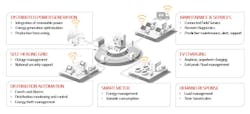Why Utilities Should Harness the Power of Private LTE Networks
Dependable and secure wireless connectivity is essential for utilities, for a variety of reasons. For starters, connectivity is critical in the development of innovative Internet of Things (IoT) applications that can help utilities increase operational efficiency, improve customer engagement, add renewable energy resources, and also provide their customers with reliable and sustainable energy services.
Think of smart meters and smart grids. These infrastructure advancements – which allow utilities to more efficiently deliver customers energy, improve customer engagement, and increase grid resiliency – simply aren’t possible without reliable connectivity. For example, IoT data can be used to create a self-healing grid that auto identifies outages and adjusts energy distribution accordingly. Likewise, utilities can increase grid stability by harnessing IoT data to perform remote diagnostics and predictive maintenance on assets in the field, thus reducing potential downtime as well as operational costs.
In addition, reliable connectivity is only going to become more important as power generation continues to diversify into areas like wind and solar. Without connectivity, utilities can’t get the real-time data on these energy sources needed to keep energy supply and demand in balance on their grids. Utilities also need connectivity to manage customer-sited energy storage systems, generators, and other distributed energy resources (DERs).
Through connectivity, utilities can use these DERs to address energy demands that might otherwise force them to purchase expensive electricity on spot markets or threaten their grid’s stability. Another benefit from connectivity is the ability to collect and analyze data on their customers’ energy use. With this data, utilities can offer new value-added services so their customers can use energy more efficiently, thus increasing customer satisfaction and engagement.
Moreover, connectivity is essential for mobile utility workers as they support day-to-day operations and, even more so, when they need to restore service after an outage. Reliable connectivity is particularly important in an era of increasing weather-related disasters – witness the devastating wildfires in Northern California, or Hurricane Dorian in the Southeastern United States – where utility workers are on the front lines, working side by side with first responders to restore energy services that are essential to the public’s safety.
Connectivity’s mission-critical role in utility operations has led many to ensure they have full control over this service. As a result, they have developed their own private communications networks for their assets, infrastructure, and people using a variety of available networking technologies. These technologies include power line carrier, proprietary wireless networks, direct terrestrial services like fiber, and DSL.
Utilities are now considering private LTE networks as a solution for many of their connectivity needs. LTE is a solution that uses widely adopted global technology standards and provides utilities with both the flexibility and control they need to meet their current and future requirements.
Why Utilities are Looking at Private LTE for Connectivity
When we mention “private LTE”, what exactly are we talking about? Private LTE networks use Long-Term Evolution (LTE) technology. The technology has long been deployed by mobile network operators (MNOs) to provide secure, high bandwidth, and broad coverage for consumers. It’s not just for MNOs anymore though: now it’s also available to utilities in private forms. Today utilities can build their own private LTE networks, independent of the MNOs, with cell sites and core network infrastructure dedicated to their use and specific requirements.
Having a private LTE network offers utilities several important advantages – conformance with global standard, flexibility, control, and cost.
Global Standards
For starters, LTE is a proven technology based on global standards that have been in place for more than a decade. It enjoys the support of a large ecosystem of partners, suppliers, infrastructure providers, and professional services, as well as ongoing oversight by the 3GPP (3rd Generation Partnership Project) standards body. Furthermore, LTE is secure and encrypted; critical factors in keeping both a utility’s network and data safe.
Moreover, as the name suggests, LTE is built for Long-Term Evolution, which future-proofs it for the introduction of new communications technologies, including 5G. For utilities, this means not having to face the specter of “ripping-and-replacing” all their networking infrastructure every five to ten years. Instead, the standard will provide a smooth migration path that allows them to maximize the value of their existing investments while taking advantage of new technological innovations.
Flexibility
Besides the ability to continually evolve, private LTE also offers a high degree of flexibility. The private LTE network can be designed for the utility’s specific application needs – and this means it can be used for a variety of both voice and data applications, ranging from high and low bandwidth. Utilities can also choose to deploy a private LTE network over their entire service territory, or just over limited parts of this territory.
Flexibility goes beyond just applications and geography though. Since LTE is standards based, with private LTE, utilities can even use MNO’s LTE networks as backup – further increasing the resiliency of their connectivity.
Control
A third advantage that private LTE offers over MNO connectivity is the level of control it affords with regards to security, coverage, and network management. Because the utility owns the network, they can ensure it delivers coverage where they need it – even to areas where public network coverage is weak or non-existent.
A private LTE network also provides utilities with a high level of control over their network’s security and other management functions. With private LTE, utilities can control every aspect of their network – for example, when maintenance is performed or when software upgrades or security patches are needed, they can be scheduled accordingly. Given that a utility may have hundreds or even thousands of devices in the field, strong network management capabilities are essential; they streamline operations while enhancing overall security.
Cost
The fourth advantage to deploying a private LTE network is the long-term cost savings the network can provide. For example, if a utility is using public carriers for AMI, mobile data, Push-To Talk, SCADA, or other services, monthly OPEX spend can be costly. A private LTE network can reduce these monthly expenditures, or even possibly eliminate them all together. Furthermore, if a private LTE network is an intricate component of a utility’s grid modernization plans, there is the potential for cost recovery for the network, if this is approved by regulators.
Key Considerations When Building a Private LTE Network
As they consider whether a private LTE network makes sense for them, or as they move forward in developing one, there are several best practices for building these networks that utilities should keep in mind.
One is to use edge-devices that support dual SIM cards. With this capability, they can begin deployment on a public carrier until their private network is built. They can also use public carriers for backup connectivity in the future if their private LTE network ever experiences a problem.
In addition, utilities need to make sure they use rugged edge-devices for their private LTE networks. There are a lot of consumer LTE edge devices available, and many can’t withstand the tough environmental conditions edge-devices experience when attached to a grid asset or installed in a utility vehicle.
They will also want to make sure they have robust device and network management software, so they can install device firmware or other updates to thousands of devices over-the-air without incurring a truck roll. This software will also provide them with insights on the condition and status of their edge devices and network, allowing them to optimize their private LTE network’s performance.
By following these best practices, and by working with experienced LTE partners, utilities can take advantage of private LTE’s flexibility, control, and cost benefits to build a global standards-based, customized, and highly resilient communications network that supports their digital transformation.
Author: Warren Westrup serves as director of business development for the utility & industrial sectors at Sierra Wireless. In his role, he partners with utility consultants, OEMs and telecom carriers so they can take full advantage of Sierra Wireless’ solutions. Westrup has more than 25 years of experience working in the electric and gas utility industry as well as experience in wireless communications. He is a licensed Professional Engineer and holds a Bachelor of Science degree in electrical engineering from the University of Texas at Austin and a Master of Business Administration degree from Our Lady of the Lake University in San Antonio.



